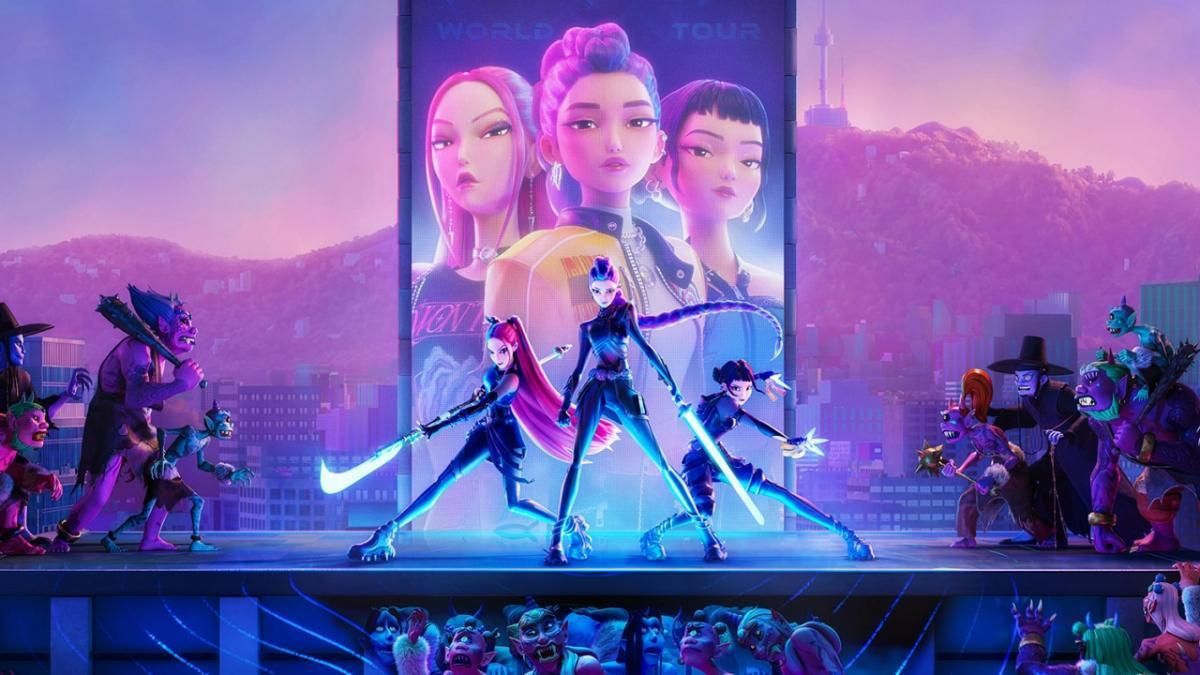
KPop Demon Hunters (hereafter KPDH), a Netflix original film by Sony Pictures Animation, is an original musical fantasy that combines K-pop and shamanism. By combining the cultural icon of idols with the traditional worldview of Korean shamanic beliefs, the film has attracted global attention with the idea of exorcising evil spirits through song. Within two months of its release, it ranked No. 1 on Netflix in 41 countries, and its OST reached the top of the Billboard main singles chart.
Idols by Day,
Hunters by Night
KPDH revolves around the three-member girl group HUNTR/X. While thrilling fans on stage, they also fight as “hunters” who protect people from evil spirits. They maintain the Honmoon, a spiritual resonance that prevents spirits from entering, through their songs.
However, the group’s main vocalist, Rumi, struggles with the inner turmoil caused by the demonic blood within her. Attempting to hide this part of herself causes tension with her teammates. Between evil and human, between the true self and the hidden self, Rumi ultimately faces herself and sings sincerely. Her heartfelt voice resonates with both her fellow members and the audience, showing that the true power to banish evil lies not in the spectacle but in sincerity.
Translating Tradition
into Modern
A key feature of KPDH is its modern reinterpretation of traditional shamanism. In shamanic belief, a shaman mediates between humans and deities, but in the film, idols fulfill that role. The stage serves as a space where collective emotions are released and comforted, overlapping the functions of a gut (a Korean exorcism ritual combining music, dance, and song) and a concert.
 A scene from KPop Demon Hunters @Netflix
A scene from KPop Demon Hunters @Netflix
The concerts are portrayed as modern-day gut rituals. Music and dance transform into shamanic rhythms, while stage lighting acts like purifying light against negative energy. This reflects the shamanic concept of purification— addressing evil not through punishment but through harmony. It is a representation of Korean culture not just as traditional imagery but as an emotional structure alive in contemporary society.
The core device, the Honmoon, similarly goes beyond a simple fantasy artifact. It is depicted as a passage for spirits and a gap created by human emotions. The protagonists struggle to seal this gate while confronting inner wounds and identity fractures. The Honmoon symbolizes the coexistence of light and shadow, good and evil, mediating inner conflicts and hidden emotions. Rumi’s loss of her voice as a half-demon represents the unsealed state of her inner Honmoon, where she confronts her own shadows.
According to Buddhist Huayan philosophy, evil does not exist as an independent entity but emerges from human perception and attachment. Instead of eliminating it, acknowledging and embracing it allows darkness to become a source of wisdom and growth. Therefore, the Honmoon represents the process of embracing one’s inner shadow to achieve self-integration. KPDH demonstrates through this process how confronting the “true self” allows resonance with others and connection to a broader world.
Sincerity, Diversity, and the
Possibility
KPDH emphasizes the power of accepting oneself as one truly is. Rumi, who has lived hiding her half-demonic identity and the resulting shame, stabilizes the Honmoon when she expresses herself sincerely through song, resonating with her fellow members and the audience. This goes beyond merely gaining strength—it conveys that growth and integration are possible when diversity is acknowledged and inner shadows are embraced. The new Rainbow Honmoon being recreated at the end symbolizes the power that comes from diversity and mutual recognition rather than uniform standards.
Significantly, this message resonates within the cultural context of Korea, often perceived as conservative and restrictive. Expressing individual identity, difference, and inner shadows is not easy in Korean society. Yet, KPDH demonstrates that true growth and integration come from overcoming these constraints and embracing sincerity and diversity.
Ultimately, the core lesson is not about past regrets but about future possibilities. Even with limited technology and capital, content rooted in Korean imagination and cultural depth can compete on the global stage. KPDH represents a first step and a model, showing Korean creators a path for new challenges.
Are we ready to accept each other and ourselves as we truly are?
The answer lies in the sincerity and resonance that emerge when we recognize ourselves despite constraints and embrace our inner diversity, demonstrating that the fusion of Korean tradition and contemporary culture opens the way to connect with the world.
Reporter
Jieun Park
pk325382@g.seoultech.ac.kr


 Comment 0
Comment 0 Posts containing profanity or personal attacks will be deleted
Posts containing profanity or personal attacks will be deleted